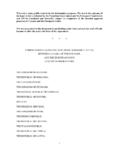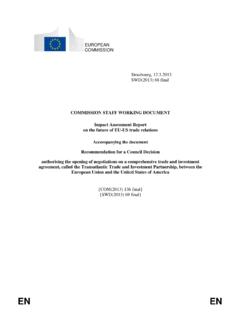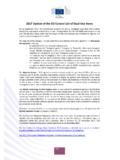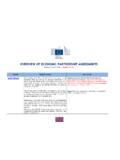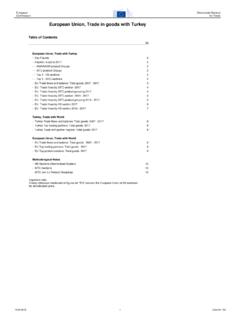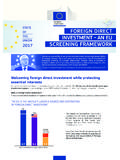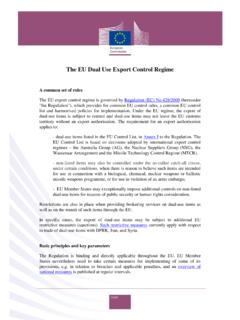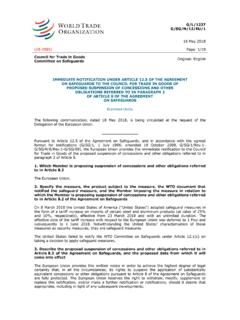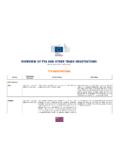Transcription of Counterfeit and Piracy Watch List - Commission staff ...
1 EN EN EUROPEAN Commission Brussels, SWD(2020) 360 final Commission staff WORKING DOCUMENT Counterfeit and Piracy Watch List 1 TABLE OF CONTENTS 1. INTRODUCTION .. 2 2. METHODOLOGY .. 7 3. RESULTS OF THE PUBLIC CONSULTATION .. 11 4. POSITIVE DEVELOPMENTS SINCE THE 2018 Watch LIST .. 13 5. NEXT STEPS .. 15 6. ONLINE SERVICE PROVIDERS OFFERING OR FACILITATING ACCESS TO COPYRIGHT-PROTECTED CONTENT .. 15 7. E-COMMERCE PLATFORMS .. 35 8. ONLINE PHARMACIES AND SERVICE PROVIDERS FACILITATING THE SALES OF MEDICINES .. 41 9. PHYSICAL MARKETPLACES .. 45 2 1. INTRODUCTION Infringements of intellectual property rights (IPR), in particular commercial-scale counterfeiting and Piracy , pose a serious problem for the European Union (EU).
2 IPR infringements not only cause high financial losses for European right holders and sustainable IP-based business models. They also pose a major threat to public health and the society at large, for instance in the form of Counterfeit medicines, medical supply and equipment. The COVID-19 pandemic is proving that criminals quickly adapt to the new trade environment and find their way to infiltrate the legitimate supply chain with their Counterfeit and often dangerous products. In terms of economic harm, the Organisation for European Co-operation and Development (OECD) and the European Union Intellectual Property Office (EUIPO) published in March 2019 an updated report1 that shows that in 2016 Counterfeit and pirated goods worth EUR 460 billion were traded worldwide, which represents a share in world trade (up from of world trade in 2013).
3 The imports of Counterfeit and pirated products into the EU amounted to as much as EUR 121 billion, which represents up to of EU imports (up from EUR 85 billion, or 5% of total EU imports in 2013). Both figures are significantly higher than in the first edition of the study three years earlier, showing that the problem of Counterfeit trade has become more serious. The five countries in the world most affected by trade in Counterfeit and pirated products are the United States, France, Italy, Switzerland and Germany2. The cumulated impact for all EU countries is double that for the United States3. The 2020 Status Report on IPR infringement4 prepared by the European Observatory on Infringements of Intellectual Property Rights found that imports of Counterfeit goods to the EU seem to be most intensive for luxury and fashion products such as leather articles and handbags, watches, perfumes and cosmetics, footwear, jewellery, and sunglasses.
4 However, counterfeiters also target common consumer products imported into the EU, such as toys and games, footwear and clothing. In addition, Counterfeit or pirated intermediary products, such as electronics goods and ICT devices or spare parts, are also frequently imported into the EU. The sectors studied (cosmetics and personal care; clothing, footwear and accessories; sports goods; toys and games; jewellery and watches; handbags and luggage; recorded music; spirits and wine; pharmaceuticals; pesticides and agrochemicals; smartphones) generated a revenue loss up to EUR 50 billion due to counterfeiting and Piracy , which is equivalent to of EU-wide sales in these sectors. This translates into a direct loss of 416 004 jobs in these sectors across the EU and a total employment loss of 671 435 jobs.
5 1 EUIPO-OECD Study on Trends in Trade in Counterfeit and Pirated Goods - 2 Seizures of Counterfeit and pirated goods: Top economies of origin of right holders, 2014 16, EUIPO OECD, Trends in Trade in Counterfeit and Pirated Goods, 2019. 3 The US account for of seizures in above-mentioned study, and the EU for 4 2020 Status Report on IPR infringement - 3 Other studies show the economic harm of Piracy on the creative industries. Since the 1980s, digital Piracy increased with annually 300 billion visits on illegal websites5. In the publishing sector, for instance, the illegal consumption of e-books ranges from 21% of all e-book readers in Germany to 92% of the e-readers in Russia and China6.
6 A study quantified the commercial value of music digital Piracy in 2015 at USD 29 billion worldwide and estimated that it could grow to USD 53-117 billion in 20227. In Spain, a report commissioned by the creative industries showed that 60% of internet users accessed illegal content up to 11 times a month in 2019, with an estimated lost profit of EUR 2 437 million8. Infringing sites constitute a parallel economy that makes hundreds of millions of euros from advertising while maintaining profit margins ranging between 86% and 93%9. Most respondents from the creative industries contributing to the public consultation have reported an increase of copyright and related rights10 infringements online during the COVID-19 pandemic.
7 The lockdown measures taken worldwide have increased users demand for access to creative content, often from illegal sources. The impact caused by copyright infringements during the pandemic is reported as particularly harmful because a number of other revenue streams for industries, authors and performers, such as theatrical release of films and music concerts, have been interrupted. In terms of risks to health, consumers and the society, the Qualitative Study11 on risks posed by counterfeits to consumers, published by the European Observatory on Infringements of Intellectual Property Rights in June 2019, presents an analysis of the RAPEX alerts from 2010 to 2017, which shows that 97% of reported dangerous Counterfeit goods were assessed as posing a serious risk to consumers.
8 The most common danger reported (32%) was related to exposure to hazardous chemicals and toxins that could cause acute or long-term health issues from immediate or long-term exposure. 24% of the dangerous products recorded as Counterfeit posed more than one danger to users. Toys are the most popular type of product followed by clothing, textiles and fashion items. In fact, the end users of 80% of the goods reported to be dangerous and Counterfeit were children (toys, childcare items and children s clothing). As regards the danger to the environment, Counterfeit pesticides often contain toxic substances that may contaminate soil, water and food. 5 MUSO report, 6 See footnote 5. 7 Frontier Economics Ltd, The Economic Impact of Counterfeiting and Piracy .
9 A Report Prepared for BASCAP and INTA , (2017): 8 9 The Digital Citizen s Alliance study Good Money still Going Bad from 2015. 10 To facilitate the reading of the document, references to copyright in the Watch List should be understood as references to copyright and related rights . 11 EUIPO s Qualitative Study on the risks posed by counterfeiters to consumers - 4 Since the outbreak of the COVID-19 pandemic, Counterfeit and falsified products, such as unproven treatments, test kits and medical equipment and supplies, masks, ventilators, or gloves, have flooded the European market. To tackle this issue the European Anti-Fraud Office (OLAF) opened an inquiry in March 2020 and has teamed up with nearly all customs and enforcement authorities in Europe and many worldwide, as well as with Europol, Interpol and EUIPO.
10 In the context of this initiative, OLAF has identified more than 800 suspicious companies acting as intermediaries or traders and has contributed to the seizure or detention of more than 14 million Counterfeit or substandard items linked to the COVID-19 pandemic. A report by Europol on Viral Marketing, counterfeits, substandard goods and intellectual property (IP) crime in the COVID-19 pandemic12 shows that the widespread demand for various products has fueled criminal enterprises to adapt quickly their product portfolios to exploit shortages of genuine products and the fear and anxieties of regular citizens. Some of the Counterfeit products distributed risk lives and the safety of frontline workers in healthcare and other essential sectors. A joint study by the EUIPO and the OECD on Trade in Counterfeit pharmaceutical products13, which was published on 23 March 2020, shows that in 2016, international trade in Counterfeit pharmaceuticals reached EUR billion.
